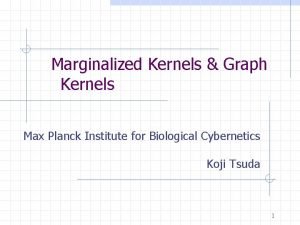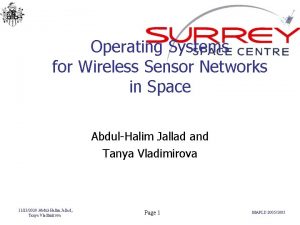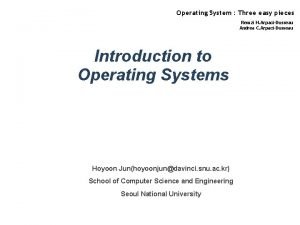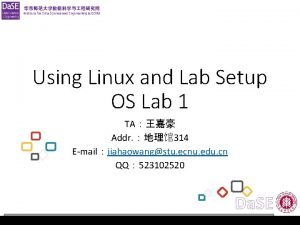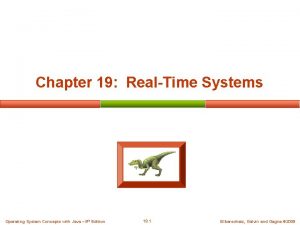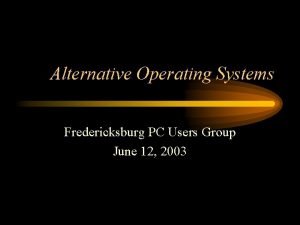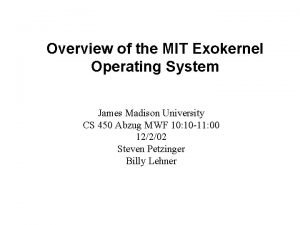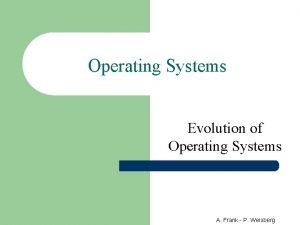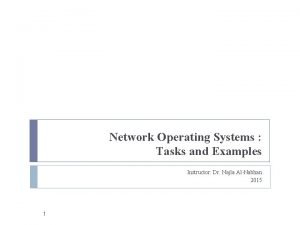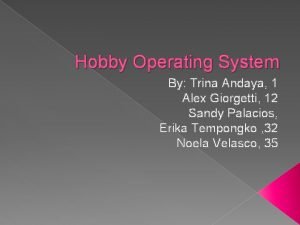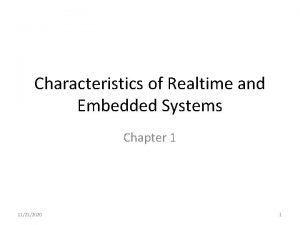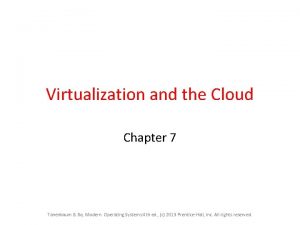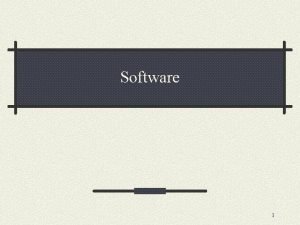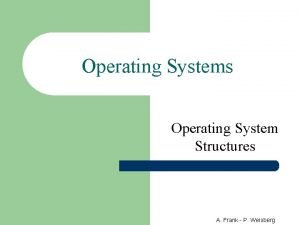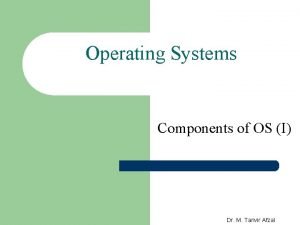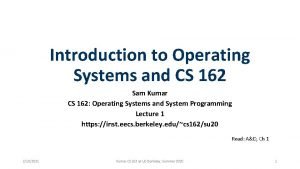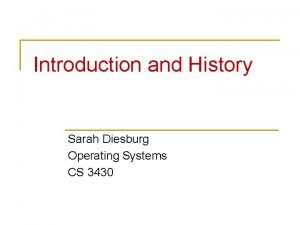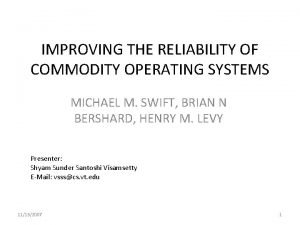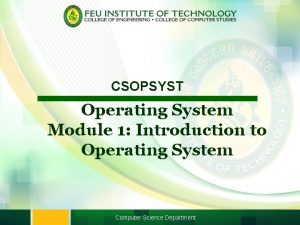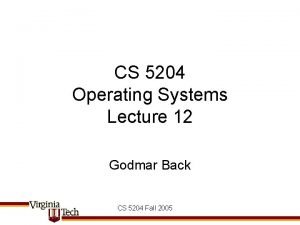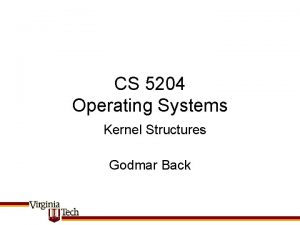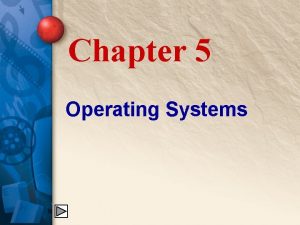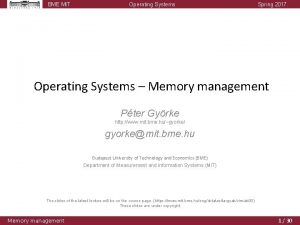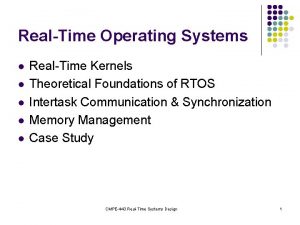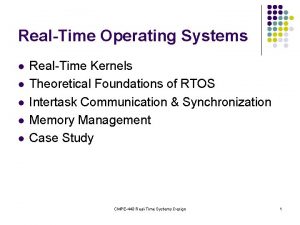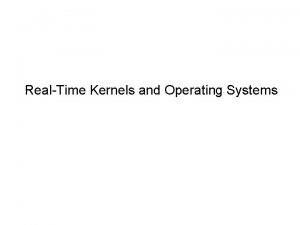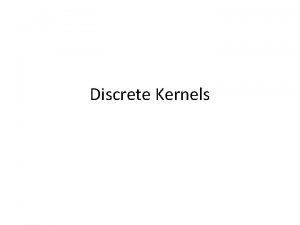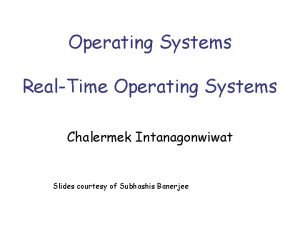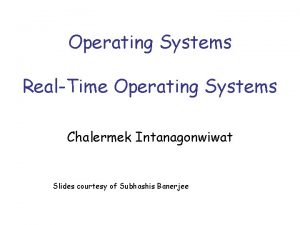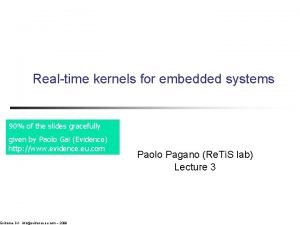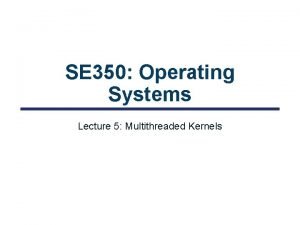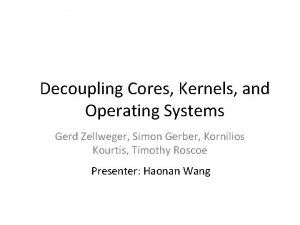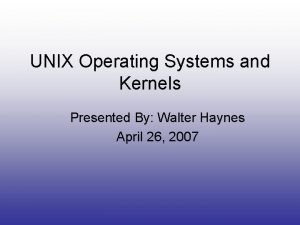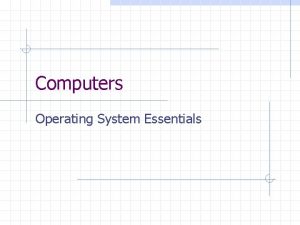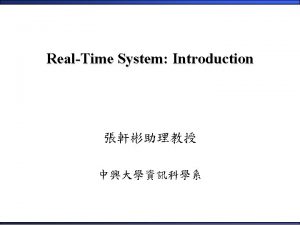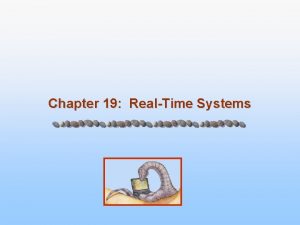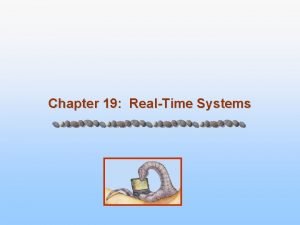RealTime Operating Systems l l l RealTime Kernels














































- Slides: 46

Real-Time Operating Systems l l l Real-Time Kernels Theoretical Foundations of RTOS Intertask Communication & Synchronization Memory Management Case Study CMPE-443 Real-Time Systems Design 1

Real-Time Kernels l l l A process is an abstraction of a running program and is the logical unit of work scheduled by OS Threads are light-weighted processes sharing resources of the parent process RTOS task management functions: scheduling, dispatching, intercommunication and synchronization CMPE-443 Real-Time Systems Design 2

Real-Time Kernels • The kernel of the OS is the smallest portion that provides for task management functions • A scheduler determines which task will run next • A dispatcher provides a necessary bookkeeping to start the next task • Intertask communication and synchronization assures that the tasks cooperate CMPE-443 Real-Time Systems Design 3

Real-Time Kernels CMPE-443 Real-Time Systems Design 4

Pseudo-kernels • Polled Loop For(; ; ){/*do forever*/ if (packet_here){/*check flag*/ process_data(); /*process data*/ packet_here=0; /*reset flag*/ } } • Synchronized polled loop For(; ; ){/*loop forever*/ if (flag){ pause(20); /* wait 20 ms to avoid switch-bounce*/ process_event(); flag=0; } } CMPE-443 Real-Time Systems Design 5

Cyclic Executives For(; ; ){/* do forever in round-robin fashion*/ Process 1(); Process 2(); . . Process. N(); } Different rates example: For(; ; ){/* do forever in round-robin fashion*/ Process 1(); Process 2(); Process 3(); /*process 3 executes 50% of the time*/ Process 3(); } CMPE-443 Real-Time Systems Design 6

State-Driven Code It uses if-then, case statements or finite state automata to break up processing of functions into code segments For(; ; ){/*dining philosophers*/ switch (state) case Think: pause(random()); state=Wait; break; case Wait: if (forks_available()) state=Eat; case Eat: pause(random()); return_forks(); state=Think; } } Return forks Eat Think Take forks Wait CMPE-443 Real-Time Systems Design 7

Coroutines Void process_i(){//code of the i-th process switch (state_i){// it is a state variable of the i-th process case 1: phase 1_i(); break; case 2: phase 2_i(); break; . . 1 2 N case N: phase_i(); break; } } Dispatcher(){ For(; ; ){ /*do forever*/ Dispatcher process_1(); . . process_M(); } CMPE-443 Real-Time Systems Design 8

Interrupt-Driven Systems Interrupt Service Routine (ISR) takes action in response to the interrupt Reentrant code can be used by multiple processes. Reentrant ISR can serve multiple interrupts. Access to critical resources in mutually exclusive mode is obtained by disabling interrupts On context switching save/restore: • General registers • PC, PSW • Coprocessor registers • Memory page register • Images of memory-mapped I/O locations The stack model is used mostly in embedded systems CMPE-443 Real-Time Systems Design 9

Pseudocode for Interrupt Driven System Main(){//initialize system, load interrupt handlers init(); while(TRUE); // infinite loop } Intr_handler_i(){// i-th interrupt handler save_context(); // save registers to the stack task_i(); // launch i-th task restore_context(); // restore context from the stack } Work with a stack: Push x: SP-=2; *SP=x; Pop x: x=*SP; SP+=2; CMPE-443 Real-Time Systems Design 10

Preemptive Priority System A higher-priority task is said to preempt a lower-priority task if it interrupts the lower-priority task The priorities assigned to each interrupt are based on the urgency of the task associated with the interrupt Prioritized interrupts can be either priority or dynamic priority Low-priority tasks can face starvation due to a lack of resources occupied by high-priority tasks In rate-monotonic systems higher priority have tasks with higher frequency (rate) Hybrid systems Foreground-background systems (FBS)– polling loop is used for some job (background task – self-testing, watchdog timers, etc) Foreground tasks run in round-robin, preemptive priority or hybrid mode FBS can be extended to a full-featured real-time OS CMPE-443 Real-Time Systems Design 11

The Task Control Model of Real-Time Operating System Each task is associated with a structure called Task Control Block (TCB). TCB keeps process’ context: PSW, PC, registers, id, status, etc TCBs may be stored as a linked list A task typically can be in one of the four following states: 1) Executing; 2) Ready; 3) Suspended (blocked); 4) Dormant (sleeping) Ready Executing Dormant Suspended RTOS maintains a list of the ready tasks’ TCBs and another list for the suspended tasks When a resource becomes available to a suspended task, it is activated CMPE-443 Real-Time Systems Design 12

Process Scheduling Pre-run time and run-time scheduling. The aim is to meet time restrictions Each task is characterized typically by the following temporal parameters: 1) Precedence constraints; 2) Release or Arrival time of j-th instance of task i; 3) Phase ; 4) Response time; 5) Absolute deadline 6) Relative deadline 7) Laxity type – notion of urgency or leeway in a task’s execution 8) Period 9) Execution time Assume for simplicity: all tasks are periodic and independent, relative deadline is a period/frame, tasks are preemptible, preemption time is neglected CMPE-443 Real-Time Systems Design 13

Round-Robin Scheduling CMPE-443 Real-Time Systems Design 14

Cyclic Executives Scheduling decisions are made periodically, rather than at arbitrary times Time intervals during scheduling decision points are referred to as frames or minor cycles, and every frame has a length, f, called the frame size The major cycle is the minimum time required to execute tasks allocated to the processor, ensuring that the deadlines and periods of all processes are met The major cycle or the hyperperiod is equal to the least common multiple (lcm) of the periods, that is, lcm(p 1, . . , pn) Scheduling decisions are made at the beginning of every frame. The phase of each task is a non-negative integer multiple of the frame size. Frames must be long enough to accommodate each task: CMPE-443 Real-Time Systems Design 15

Cyclic Executives Hyperperiod should be a multiple of the frame size: To ensure that every task completes by its deadline, frames must be small so that between the release time and deadline of every task, there is at least one frame. Quantifier of existence!! Logical OR CMPE-443 Real-Time Systems Design 16

Cyclic Executives The following relation is derived for a worst-case scenario, which occurs when the period of a process starts just after the beginning of a frame, and, consequently, the process cannot be released until the next frame: CMPE-443 Real-Time Systems Design 17

Cyclic Executives CMPE-443 Real-Time Systems Design 18

Hyperperiod 15=1*3*5; 20=1*2*2*5; 22=1*2*11; h=3*5*2*2*11=15*4*11=60*11=660=lcm(15, 20, 22) F=2 For all; quantifier of generality; AND Gcd(15, 2)=1; 2=1*2; 2*2 -1=3<=14; yes 2*2 -gcd(20, 2)=4 -2=2<=26; yes 2*2 -gcd(22, 2)=4 -2=2<=22; yes F=3 2*3 -gcd(15, 3)=6 -3=3<=14; yes 2*3 -gcd(20, 3)=6 -1=5<=26; yes 2*3 -gcd(22, 3)=6 -1=5<=22; yes F=4 2*4 -gcd(15, 4)=8 -1=7<=14; yes 2*4 -gcd(20, 4)=8 -4=4<=26; yes 2*4 -gcd(22, 4)=8 -2=6<=22; yes F=10 2*10 -gcd(15, 10)=20 -5=15<=14; no 2*10 -gcd(20, 10)=20 -10=10<=26; yes 2*10 -gcd(22, 10)=20 -2=18<=22; yes CMPE-443 Real-Time Systems Design 19

Cyclic Executives For example, for tasks T 1(4, 1), T 2(5, 1. 8), T 3(20, 1), T 4(20, 2), hyper -period is 20 (without and with frames – f=2) CMPE-443 Real-Time Systems Design 20

Fixed Priority Scheduling – Rate-Monotonic Approach CMPE-443 Real-Time Systems Design 21

Rate-Monotonic Scheduling Theorem (RMA Bound). Any set of n periodic tasks is RM schedulable if the processor utilization CMPE-443 Real-Time Systems Design 22

Dynamic-Priority Scheduling – Earliest-Deadline -First Approach Theorem (EDF Bound). A set of n periodic tasks, each of whose relative deadline equals its period, can be feasibly scheduled by EDF if and only if CMPE-443 Real-Time Systems Design 23

Intertask Communication and Synchronization • Buffering data • Double-buffering CMPE-443 Real-Time Systems Design 24

Intertask Communication and Synchronization Ring Buffers CMPE-443 Real-Time Systems Design 25

Intertask Communication and Synchronization CMPE-443 Real-Time Systems Design 26

Intertask Communication and Synchronization Mailbox: void pend (int data, s); void post (int data, s); Access to mailbox is mutually exclusive; tasks wait access granting CMPE-443 Real-Time Systems Design 27

Intertask Communication and Synchronization • Queues – can be implemented with ring buffers • Critical regions – sections of code to be used in the mutually exclusive mode • Semaphores – can be used to provide critical regions CMPE-443 Real-Time Systems Design 28

Intertask Communication and Synchronization Mailboxes and Semaphores CMPE-443 Real-Time Systems Design 29

Intertask Communication and Synchronization Semaphores and mailboxes Sema mutex=0/*open*/, proc_sem=1; /*closed*/ Bool full_slots=0, empty_slots=1; Void post( int mailbox, int message){ while (1){ wait(mutex); if (empty_slots){ insert(mailbox, message); update(); signal(mutex); signal(proc_sem); break; } else{ signal(mutex); wait(proc_sem); } } } CMPE-443 Real-Time Systems Design 30

Intertask Communication and Synchronization Semaphores and mailboxes Void pend( int mailbox, int *message){ while (1){ wait(mutex); if (full_slots){ extract(mailbox, message); update(); signal(mutex); signal(proc_sem); break; } else{ signal(mutex); wait(proc_sem); } } } CMPE-443 Real-Time Systems Design 31

Intertask Communication and Synchronization Driver{ while(1){ if(data_for_I/O){ prepare(command); V(busy); P(done); } }} Controller{while(1){ P(busy); exec(command); V(done); }} CMPE-443 Real-Time Systems Design 32

Intertask Communication and Synchronization Counting Semaphores: Wait: void MP(int &S){ S=S-1; while(S<0); } Signal: void MV(int &S){ S=S+1 } CMPE-443 Real-Time Systems Design 33

Intertask Communication and Synchronization CMPE-443 Real-Time Systems Design 34

Intertask Communication and Synchronization Problems with semaphores: Wait: void P(int &S){ while(S==TRUE); S=TRUE; } @1 LOAD R 1, S ; address of S in R 1 LOAD R 2, 1 ; 1 in R 2 TEST R 1, I, R 2 ; compare (R 1)=*S with R 2=1 JEQ @1 STORE R 2, S, I ; repeat if *S=1 ; store 1 in *S Interruption between JEQ and STORE, passing control to a next process, can cause that several processes will see *S=FALSE CMPE-443 Real-Time Systems Design 35

Intertask Communication and Synchronization The Test-and-Set Instruction Void P(int &S){ while(test_and_set(S)==TRUE); //wait } Void V(int &S){ S=FALSE; } The instruction fetches a word from memory and tests the highorder (or other) bit. If the bit is 0, it is set to 1 and stored again, and a condition code of 0 is returned. If the bit is 1, a condition code of 1 is returned and no store is performed. The fetch, test and store are indivisible. CMPE-443 Real-Time Systems Design 36

Intertask Communication and Synchronization Dijkstra’s implementation of semaphore operation (if test-and-set instruction is not available): Void P(int &S){ int temp=TRUE; while(temp){ disable(); //disable interrupts temp=S; S=TRUE; enable(); //enable interrupts } } CMPE-443 Real-Time Systems Design 37

Intertask Communication and Synchronization Other Synchronization Mechanisms: • Monitors (generalize critical sections – only one process can execute monitor at a time. Provide public interface for serial use of resources • Events – similar to semaphores, but usually all waiting processes are released when the event is signaled. Tasks waiting for event are called blocked Deadlocks CMPE-443 Real-Time Systems Design 38

Intertask Communication and Synchronization Deadllocks: CMPE-443 Real-Time Systems Design 39

Deadlocks Four conditions are necessary for deadlock: • Mutual exclusion • Circular wait • Hold and wait • No preemption Eliminating any one of the four necessary conditions will prevent deadlock from occurring One way to eliminate circular wait is to number resources and give all the resources with the numbers greater or equal than minimal required to processes. For example: Disk – 1, Printer – 2, Motor control – 3, Monitor – 4. If a process wishes to use printer, it will be assigned printer, motor control and monitor. If another process requires monitor, it will have wait until the monitor will be released. This may lead to starvation. CMPE-443 Real-Time Systems Design 40

Deadlock avoidance To avoid deadlocks, it is recommended : • Minimize the number of critical regions as well as minimizing their size • All processes must release any lock before returning to the calling function • Do not suspend any task while it controls a critical region • All critical regions must be error-free • Do not lock devices in interrupt handlers • Always perform validity checks on pointers used within critical regions. It is difficult to follow these recommendations CMPE-443 Real-Time Systems Design 41

The Banker’s Algorithm Suggested by Dijkstra in 1968 for a single resource, but then was extended to multiple resource types by Habermann in 1969. Consider a system with three processes: Process Possibly needed A Max Used requirem ent 6 0 B 5 0 5 C 7 0 7 6 Total 10 available CMPE-443 Real-Time Systems Design 42

The Banker’s Algorithm When resources are requested, the operating system updates the table, ensuring that a possible deadlock state is not reached. An example of a “safe state” is Process Possibly needed A Max Used requirem ent 6 2 B 5 3 2 C 7 1 6 4 Total 4 available CMPE-443 Real-Time Systems Design 43

The Banker’s Algorithm An example of an “unsafe state” is: Process Possibly needed A Max Used requirem ent 6 4 B 5 3 2 C 7 2 5 2 Total 1 available CMPE-443 Real-Time Systems Design 44

The Banker’s Algorithm The case of multiple resources. Initial resource state: Safe state: CMPE-443 Real-Time Systems Design 45

The Banker’s Algorithm CMPE-443 Real-Time Systems Design 46
 Real time characteristics of embedded operating systems
Real time characteristics of embedded operating systems Cis419
Cis419 Aldi popping corn
Aldi popping corn Walnut kernels meaning
Walnut kernels meaning Protein function prediction via graph kernels
Protein function prediction via graph kernels Parallel research kernels
Parallel research kernels Examples for operating systems
Examples for operating systems Evolution of operating systems
Evolution of operating systems Components of an operating system
Components of an operating system Components of operating system
Components of operating system Wsn operating systems
Wsn operating systems Three easy pieces
Three easy pieces Operating systems lab
Operating systems lab Introduction to operating systems
Introduction to operating systems Tanenbaum os
Tanenbaum os File management in operating system
File management in operating system Design issues in distributed system
Design issues in distributed system Early operating systems
Early operating systems Real-time operating systems
Real-time operating systems Can we make operating systems reliable and secure
Can we make operating systems reliable and secure Alternative operating systems
Alternative operating systems Exo os
Exo os Operating systems: internals and design principles
Operating systems: internals and design principles Evolution of operating systems
Evolution of operating systems Examples of network operating systems
Examples of network operating systems Msdn subscription levels
Msdn subscription levels Menuet os
Menuet os Embedded system characteristics
Embedded system characteristics Operating systems concepts
Operating systems concepts Understanding operating system
Understanding operating system Virtualization technology in modern operating systems
Virtualization technology in modern operating systems Computer software can be divided into how many parts
Computer software can be divided into how many parts Structures of operating system
Structures of operating system Components of operating systems
Components of operating systems Os architecture
Os architecture Module 4 operating systems and file management
Module 4 operating systems and file management Modern operating systems 3rd edition
Modern operating systems 3rd edition Cs162 summer 2021
Cs162 summer 2021 Operating systems
Operating systems Improving the reliability of commodity operating systems
Improving the reliability of commodity operating systems Overview of operating systems
Overview of operating systems Operating systems
Operating systems Operating systems structure
Operating systems structure Modern operating systems tanenbaum 5th edition
Modern operating systems tanenbaum 5th edition What are 5 operating systems?
What are 5 operating systems? Mit operating systems
Mit operating systems Advanced operating system notes
Advanced operating system notes




